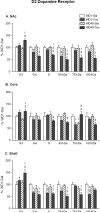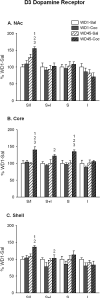Dopamine receptor expression and distribution dynamically change in the rat nucleus accumbens after withdrawal from cocaine self-administration
- PMID: 20435100
- PMCID: PMC2901771
- DOI: 10.1016/j.neuroscience.2010.04.056
Dopamine receptor expression and distribution dynamically change in the rat nucleus accumbens after withdrawal from cocaine self-administration
Abstract
Dopamine receptors (DARs) in the nucleus accumbens (NAc) are critical for cocaine's actions but the nature of adaptations in DAR function after repeated cocaine exposure remains controversial. This may be due in part to the fact that different methods used in previous studies measured different DAR pools. In the present study, we used a protein crosslinking assay to make the first measurements of DAR surface expression in the NAc of cocaine-experienced rats. Intracellular and total receptor levels were also quantified. Rats self-administered saline or cocaine for 10 days. The entire NAc, or core and shell subregions, were collected one or 45 days later, when rats are known to exhibit low and high levels of cue-induced drug seeking, respectively. We found increased cell surface D1 DARs in the NAc shell on the first day after discontinuing cocaine self-administration (designated withdrawal day 1, or WD1) but this normalized by WD45. Decreased intracellular and surface D2 DAR levels were observed in the cocaine group. In shell, both measures decreased on WD1 and WD45. In core, decreased D2 DAR surface expression was only observed on WD45. Similarly, WD45 but not WD1 was associated with increased D3 DAR surface expression in the core. Taking into account many other studies, we suggest that decreased D2 DAR and increased D3 DAR surface expression on WD45 may contribute to enhanced cocaine-seeking after prolonged withdrawal, although this is likely to be a modulatory effect, in light of the mediating effect previously demonstrated for AMPA-type glutamate receptors.
Copyright (c) 2010 IBRO. Published by Elsevier Ltd. All rights reserved.
Figures




References
-
- Alleweireldt AT, Hobbs RJ, Taylor AR, Neisewander JL. Effects of SCH-23390 infused into the amygdala or adjacent cortex and basal ganglia on cocaine seeking and self-administration in rats. Neuropsychopharmacology. 2006;31:363–374. - PubMed
-
- Anderson SM, Bari AA, Pierce RC. Administration of the D1-like dopamine receptor antagonist SCH-23390 into the medial nucleus accumbens shell attenuates cocaine priming-induced reinstatement of drug-seeking behavior in rats. Psychopharmacology (Berl) 2003;168:132–138. - PubMed
-
- Anderson SM, Famous KR, Sadri-Vakili G, Kumaresan V, Schmidt HD, Bass CE, Terwilliger EF, Cha JH, Pierce RC. CaMKII: a biochemical bridge linking accumbens dopamine and glutamate systems in cocaine seeking. Nat Neurosci. 2008;11:344–353. - PubMed
-
- Anderson SM, Pierce RC. Cocaine-induced alterations in dopamine receptor signaling: implications for reinforcement and reinstatement. Pharmacol and Ther. 2005;106:389–403. - PubMed
-
- Bachtell RK, Whisler K, Karanian D, Self DW. Effects of intra-nucleus accumbens shell administration of dopamine agonists and antagonists on cocaine-taking and cocaine-seeking behaviors in the rat. Psychopharmacology (Berl) 2005;183:41–53. - PubMed
Publication types
MeSH terms
Substances
Grants and funding
LinkOut - more resources
Full Text Sources
Medical

